|
Featured picture tools: |
These featured pictures, as scheduled below, appeared as the picture of the day (POTD) on the English Wikipedia's Main Page in May 2024. Individual sections for each day on this page can be linked to with the day number as the anchor name (e.g. [[Wikipedia:Picture of the day/May 2024#1]] for May 1).
You can add an automatically updating POTD template to your user page using {{Pic of the day}} (version with blurb) or {{POTD}} (version without blurb). For instructions on how to make custom POTD layouts, see Wikipedia:Picture of the day.Purge server cache
May 1
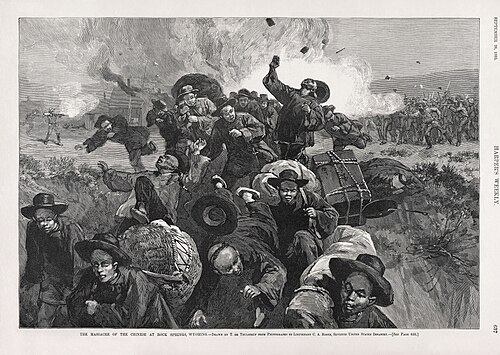
|
|
The Rock Springs massacre occurred in 1885 in the present-day United States city of Rock Springs, Wyoming. The riot, and resulting massacre of immigrant Chinese miners by white immigrant miners, was the result of racial prejudice toward the Chinese miners, who were perceived to be taking jobs from the white miners. The Union Pacific Coal Department found it economically beneficial to give preference in hiring to Chinese miners, who were willing to work for lower wages than their white counterparts, angering the white miners. When the rioting ended, at least 28 Chinese miners were dead and 15 were injured. Rioters burned 78 Chinese homes, resulting in approximately $150,000 in property damage (equal to $5.09 million in 2020 terms). The massacre in Rock Springs touched off a wave of anti-Chinese violence, especially in the Puget Sound area of Washington Territory. Artwork credit: Thure de Thulstrup; restored by Adam Cuerden
Recently featured:
|
May 2

|
|
John Rocque's maps of London were published in 1746. A French-born British surveyor and cartographer, John Rocque produced two maps of London and the surrounding area. The better known of these, depicted here, is a 24-sheet map of the City of London and the surrounding area, surveyed by Rocque and engraved by John Pine and titled A Plan of the Cities of London and Westminster, and Borough of Southwark. Rocque combined two surveying techniques: he made a ground-level survey with a compass and a physical metal chain – the unit of length also being the chain. Compass bearings were taken of the lines measured. He also created a triangulation network over the entire area to be covered by taking readings from church towers and similar high places using a theodolite made by Jonathan Sisson (the inventor of the telescopic-sighted theodolite) to measure the observed angle between two other prominent locations. The process was repeated from point to point. This image depicts all 24 sheets of Rocque's map. Map credit: John Rocque and John Pine
Recently featured:
|
May 3

|
The great blue turaco (Corythaeola cristata) is a bird species in the turaco family, Musophagidae, which is widespread throughout the African tropical rainforest. It has a typical length of around 75 cm (30 in) with a mass of around 1 kg (2 lb). The adult great blue turaco has predominantly gray-blue upperparts with an upright blue-black crest. Its bill is yellow and the two sexes have similar plumage. This great blue turaco was photographed in Kibale National Park, Uganda. Photograph credit: Giles Laurent
Recently featured:
|
May 4

|
|
The Nazca lines are a group of geoglyphs made in the soil of the Nazca Desert in southern Peru. They were created in two major phases – the Paracas phase (from 400 to 200 BC) and the Nazca phase (from 200 BC to 500 AD). The combined length of all the lines is more than 1,300 km (800 mi), and the group covers an area of about 50 km2 (19 sq mi). Most lines run straight across the landscape, but there are also figurative designs of animals and plants. Scholars differ in interpreting the purpose of the designs, but in general, they ascribe religious significance to them. The lines were designated as a UNESCO World Heritage Site in 1994. This is an aerial view of the geoglyph known as the "monkey", one of the most well-known of the Nazca lines. Photograph credit: Diego Delso
Recently featured:
|
May 5

|
Ruddigore is a comic opera in two acts, with music by Arthur Sullivan and a libretto by W. S. Gilbert. The tenth of fourteen comic operas written together by Gilbert and Sullivan, it was first performed by the D'Oyly Carte Opera Company at the Savoy Theatre in London in 1887. Some critics and audience members initially felt that Ruddygore (its original title) did not measure up to its predecessor, The Mikado. After changes, including respelling the title, it achieved a run of 288 performances and was profitable. This 1887 illustration by Amédée Forestier depicts scenes and characters from Ruddygore for The Illustrated London News. Since D'Oyly Carte revived the piece in 1920, it has been regularly performed. Illustration credit: Amédée Forestier; restored by Adam Cuerden
Recently featured:
|
May 6

|
|
Phoenicolacerta troodica, commonly known as the Troodos lizard or the Troodos wall lizard, is a species of lizard in the family Lacertidae. It is endemic to Cyprus, where it is common and widespread and its natural habitats are Mediterranean-type shrubland and rocky areas, in both rural and urban areas. Its length is up to 22 centimetres (8.7 inches), with males slightly larger than females. The species has a long tail, which can grow to more than twice its body length. This P. troodica lizard was photographed under the Elia Bridge in Limassol District, Cyprus. Photograph credit: Charles J. Sharp
Recently featured:
|
May 7
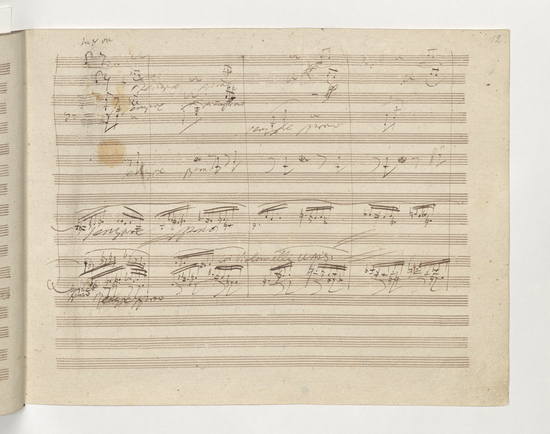
|
|
The Symphony No. 9 in D minor, Op. 125, is a choral symphony, the final complete symphony by Ludwig van Beethoven, composed between 1822 and 1824. It was first performed in Vienna on 7 May 1824. The symphony is regarded by many critics and musicologists as a masterpiece of Western classical music. It is one of the best-known works in common practice music and one of the most frequently performed symphonies worldwide. Symphony No. 9 was the first example of a major composer scoring vocal parts in a symphony. In the 20th century, an instrumental arrangement of the chorus was adopted by the Council of Europe, and later the European Union, as the Anthem of Europe. This photograph displays page 12 of Beethoven's original manuscript and is currently held in the collection of the Berlin State Library. Manuscript credit: Ludwig van Beethoven
Recently featured:
|
May 8

|
Heungseon Daewongun (1821–1898) was the title of Yi Ha-eung, the regent of Joseon during the minority of Emperor Gojong in the 1860s. Until his death, he was a key political figure of late-Joseon Korea. The Daewongun is remembered both for the wide-ranging reforms that he attempted during his regency, as well as for what was described by historian Hilary Conroy as "vigorous enforcement of the seclusion policy, persecution of Christians, and the killing or driving off of foreigners who landed on Korean soil". This silk painting of the Daewongun, now in the collection of the National Museum of Korea, was created by an unknown artist circa 1869. It is designated as a Treasure of Korea. Painting credit: unknown
Recently featured:
|
May 9

|
The acorn woodpecker (Melanerpes formicivorus) is a bird in the woodpecker family, Picidae. It is found across Central America, as well as the western United States and parts of Colombia. A medium-sized bird, it has a length of around 20 cm (8 in) and is mostly black, and adult males have a red cap starting at the forehead and females a black area between the forehead and the cap. As their name implies, acorn woodpeckers are heavily dependent on acorns for food, which they store in small holes that they drill into trees, known as "granaries" or "storage trees". This acorn woodpecker was photographed in the grounds of California State University, Chico, United States. Photograph credit: Frank Schulenburg
Recently featured:
|
May 10

|
The Rokeby Venus is a painting by Diego Velázquez which was completed between 1647 and 1651. It depicts the Roman goddess Venus in a sensual pose, lying on a bed and looking into a mirror held by her son Cupid. The painting is the only surviving female nude by Velázquez. Since 1906 it has been in the National Gallery in London. Painting: Diego Velázquez
Recently featured:
|
May 11

|
|
Sagunto is a municipality of Spain, located in the province of Valencia, approximately 30 km (19 mi) north of the city of Valencia. The municipality includes three differentiated urban nuclei: Ciutat Vella (Sagunto), Grau Vella and Puerto de Sagunto. More than half of the population lives in Puerto de Sagunto, situated on the Mediterranean Costa del Azahar. The Ciutat Vella is the site of the ancient Iberian and Roman city of Saguntum and a siege in 219 BC which was the trigger of the Second Punic War between the Carthaginians and the Romans. This panorama shows the Ciutat Vella, looking north from the hill on which Sagunto Castle stands. Photograph credit: Diego Delso
Recently featured:
|
May 12
|
Carpocoris purpureipennis is a species in the shield bug family, Pentatomidae. With a length of 11–13 millimetres (0.43–0.51 in), its body color varies from purple or reddish-brown to yellowish. The pronotum angles are black and the pronotum usually shows short longitudinal black stripes, while the scutellum may have some contrasting black spots. The insect's antennae are black and its legs are orange. Both the adult bugs and their nymphs are polyphagous. Adults mainly feed on juices of Cirsium arvense and nectar of Leucanthemum vulgare. These images show top and bottom views of a C. purpureipennis nymph. Photograph credit: Ivar Leidus
Recently featured:
|
May 13

|
|
The Monteleone chariot is an Etruscan chariot, dated to circa 530 BC, that was uncovered in 1902 at Monteleone di Spoleto in Umbria, Italy, in an underground tomb covered by a mound. It was part of a chariot burial, containing the remains of two human corpses along with two drinking cups. Measuring 131 centimetres (51+5⁄8 inches) in height and designed to be drawn by two horses, the chariot itself is constructed of wood covered with hammered bronze plates and carved ivory decoration. The Monteleone chariot is now in the collection of the Metropolitan Museum of Art in New York City. Artifact credit: unknown Etruscan sculptor; photographed by the Rogers Fund and the Metropolitan Museum of Art
Recently featured:
|
May 14
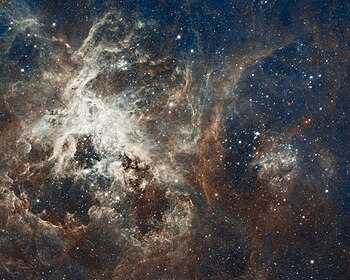
|
The Tarantula Nebula, also known as 30 Doradus, is a large H II region in the Large Magellanic Cloud (LMC). It is one of the largest H II regions in the Local Group, with an estimated diameter around 650 to 1860 light years. It is around 160,000 light-years from Earth and has apparent magnitude of 8. The Tarantula Nebula was first observed by Nicolas-Louis de Lacaille during an expedition to the Cape of Good Hope between 1751 and 1753. This high-resolution photograph was taken by the Hubble Space Telescope and shows the star-forming region of Tarantula Nebula with the R136 super star cluster at its center. Photograph credit: NASA, ESA, Space Telescope Science Institute
Recently featured:
|
May 15

|
The sword-billed hummingbird (Ensifera ensifera) is a neotropical species of hummingbird from the Andean regions of South America. Among the largest species of hummingbird, it is characterized by its unusually long beak, being the only bird to have a beak longer than the rest of its body, excluding the tail. It uses this to drink nectar from flowers with long corollas and has coevolved with the plant Passiflora mixta. While most hummingbirds preen using their beaks, the sword-billed hummingbird uses its feet to scratch and preen due to its beak being so long. Photograph credit: Andy Morffew
Recently featured:
|
May 16

|
|
The Valère Basilica is a fortified Catholic church in Sion, in the Swiss canton of Valais. It is situated on a hill at an altitude of 615 metres (2,018 ft), and faces Tourbillon Castle located on the opposite hill. The first parts of the building were constructed around 1100, with numerous additions over the subsequent centuries. It was designated a minor basilica in 1987. The site is a listed as a Swiss heritage site of national significance, which includes the surrounding hill due to the large number of protected plant and animal species present there. This photograph shows the Valère Basilica in February 2021, with the Haut de Cry, a 2,969-metre (9,741 ft) peak of the Bernese Alps, in the background. Photograph credit: Christian David
Recently featured:
|
May 17
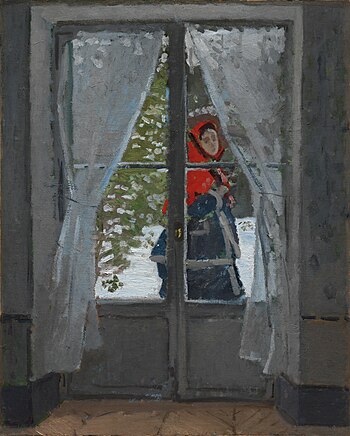
|
The Red Cape, also known as Madame Monet or The Red Kerchief, is an oil-on-canvas snowscape by the French Impressionist artist Claude Monet. Painted around 1868 to 1878, it depicts Monet's wife, Camille, passing outside a window dressed in a red cape as seen from inside a house. Monet created the painting while living in Argenteuil and the solitary setting at his home there allowed him to paint in relative peace, as well as spend time with his family. It is Monet's only known snowscape painting featuring Camille. The Red Cape is now in the collection of the Cleveland Museum of Art in Ohio, United States. Painting credit: Claude Monet
Recently featured:
|
May 18

|
Sea urchins are a group of spiny globular echinoderms which form the class Echinoidea. About 950 species live on the seabed, inhabiting all oceans and depth zones from the intertidal to 5,000 metres (16,000 feet; 2,700 fathoms). Their tests (hard shells) are round and spiny, typically from 3 to 10 centimetres (1 to 4 inches) across. Sea urchins move slowly, crawling with their tube feet, and sometimes pushing themselves with their spines. They feed primarily on algae but also eat slow-moving or sessile animals. Their predators include sea otters, starfish, wolf eels, and triggerfish. This photograph, taken off the northern coast of Haiti near Cap-Haïtien, shows two species of sea urchin: a West Indian sea egg (top) and a reef urchin (bottom). Photograph credit: Nick Hobgood, edited by Lycaon
Recently featured:
|
May 19

|
The acorn is the nut of the oak tree and its close relatives, in the family Fagaceae. Acorns usually contain a seedling surrounded by two cotyledons (seedling leaves), enclosed in a tough shell known as the pericarp, and borne in a cup-shaped cupule. This acorn of the species Quercus robur (the pedunculate oak), with a length of 25 millimetres (1 inch), was photographed in Keila, Estonia. Photograph credit: Ivar Leidus
Recently featured:
|
May 20
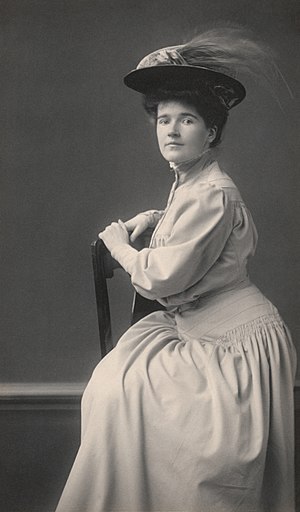
|
Lucia Chamberlain (1882–1978) was an American novelist. Her 1909 book was the basis of the 1916 film The Other Side of the Door, and her 1917 short story "The Underside" formed the basis of the 1920 film Blackmail. The 1916 film The Wedding Guest is also based on her writing. This photograph of Chamberlain was taken around 1908 by the American portrait photographer Zaida Ben-Yusuf, and is now in the collection of the National Portrait Gallery in Washington, D.C. Photograph credit: Zaida Ben-Yusuf; restored by Adam Cuerden
Recently featured:
|
May 21
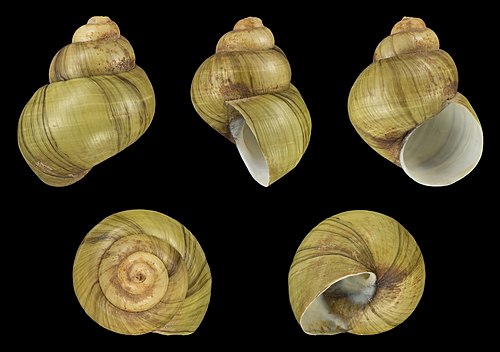
|
|
Viviparus georgianus, commonly known as the banded mystery snail, is a species of large freshwater snail in the family Viviparidae, the river snails. It is native to North America, generally found from the northeastern United States to Florida and the Gulf of Mexico, and thrives in eutrophic lentic environments such as lakes, ponds and some low-flow streams. The snail has two distinct sexes and reproduces more than once in a lifetime, with females laying eggs singly in albumen-filled capsules. It feeds on diatom clusters found on silt and mud substrates, but it may also require the ingestion of some grit to be able to break down algae. This image shows five views of a 2.1 cm high (0.83 in) V. georgianus shell, originally collected in the U.S. state of Georgia and now in the collection of the State Museum of Natural History Karlsruhe in Germany. Photograph credit: H. Zell
Recently featured:
|
May 22
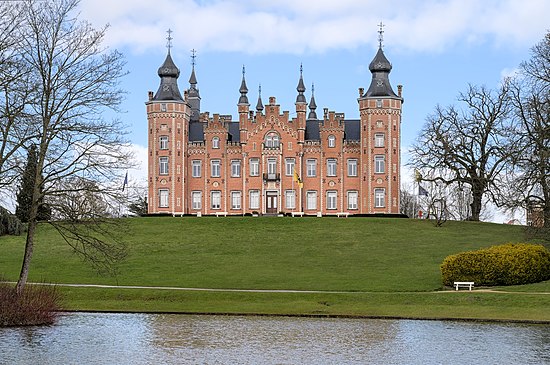
|
|
De Viron Castle is a castle in the town of Dilbeek in Flemish Brabant, Belgium. Commissioned by the de Viron family, which settled in Dilbeek in 1775, the castle was built in 1863 by Jean-Pierre Cluysenaar. The Tudor-style castle was built on the ruins of a 14th-century fortification that was destroyed in 1862. One of the medieval towers, the Sint-Alenatoren, can still be seen in the park surrounding the current building and is named after Saint Alena, who lived in Dilbeek. The castle has served as the town hall of Dilbeek and housed the offices of the municipality since 1923, and was listed as a Belgian protected monument in 1990. This photograph shows the facade of De Viron Castle with the surrounding park in the foreground. Photograph credit: Benoit Brummer
Recently featured:
|
May 23

|
|
InSight was an American spacecraft mission launched by NASA and the Jet Propulsion Laboratory, consisting of a robotic lander designed to study the deep interior of the planet Mars. Launched in 2018, the mission was active until late 2022, when contact with the lander was lost. InSight's objectives were to place a seismometer on the surface of Mars to measure seismic activity and provide accurate three-dimensional models of the planet's interior, and to measure internal heat transfer using a heat probe to study Mars's early geological evolution. This was intended to provide a new understanding of how the Solar System's terrestrial planets (Mercury, Venus, Earth and Mars) as well as the Moon formed and evolved. This 2015 photograph shows three technicians working on the InSight lander with its solar panels deployed during preflight testing in a cleanroom in Denver, Colorado. Photograph credit: NASA / JPL-Caltech / Lockheed Martin
Recently featured:
|
May 24

|
Ethel Smyth (1858–1944) was an English composer and a member of the women's suffrage movement. Her compositions include songs, works for piano, chamber music, orchestral works, choral works and operas. Smyth's extensive body of work includes the Concerto for Violin, Horn and Orchestra, and the Mass in D. Her opera The Wreckers is considered by some critics to be the "most important English opera composed during the period between Purcell and Britten". This photograph of Smyth was taken in 1922. Photograph credit: unknown; restored by Adam Cuerden
Recently featured:
|
May 25
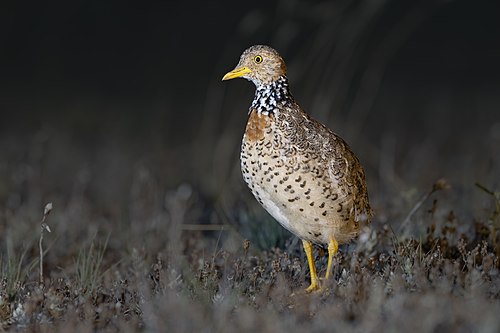
|
|
The plains-wanderer (Pedionomus torquatus) is a bird in the family Pedionomidae, of which it is the only surviving species. Endemic to Australia, its historical range included Victoria, New South Wales, South Australia and the Northern Territory, but in recent years it has become endangered, with remaining known populations concentrated in the Riverina (a region in southwestern New South Wales) and western Queensland. The plains-wanderer is a quail-like ground bird, measuring 15 to 19 centimetres (5.9 to 7.5 in). The adult male is light brown above, with fawn-white underparts with black crescents. The adult female is substantially larger than the male and has a distinctive white-spotted black collar. This female plains-wanderer was photographed in the Riverina, north of the town of Deniliquin, New South Wales. Photograph credit: John Harrison
Recently featured:
|
May 26

|
|
The Giechburg is a partly reconstructed hilltop castle located in the town of Scheßlitz in Bavaria, Germany. There was a hilltop fort at the site from at least Neolithic times, and the castle enters written history in 1125. In 1390, it entered the possession of the prince-bishops of Bamberg, and its history thereafter is closely allied to the bishopric and the city of Bamberg. The castle was destroyed and rebuilt several times over the subsequent centuries before undergoing extensive redevelopment between 1599 and 1609. It became less useful to the prince-bishops over the subsequent centuries however, and eventually fell into ruin. After a period in the 19th and 20th centuries in the hands of the von Giech family, the castle was eventually acquired by the district of Bamberg in 1971 and reconstructed as a conference and hospitality centre. This 2021 aerial photograph shows the Giechburg viewed from the north, with the village of Peulendorf in the background. Photograph credit: Reinhold Möller
Recently featured:
|
May 27

|
Wheat Fields is a series of dozens of paintings by Dutch artist Vincent van Gogh. The close association of peasants and the cycles of nature particularly interested Van Gogh, such as the sowing of seeds, harvest and sheaves of wheat in the fields. Van Gogh saw plowing, sowing and harvesting symbolic to man's efforts to overwhelm the cycles of nature. This oil-on-canvas Wheat Fields painting, also sometimes known as Wheat Field with Alpilles Foothills in the Background, was created in June 1888 and is now in the Van Gogh Museum in Amsterdam. Painting credit: Vincent van Gogh
Recently featured:
|
May 28

|
Acraea terpsicore, commonly known as the tawny coster, is a species of butterfly in the Nymphalidae family, the brush-footed butterflies. It is found across eastern Asia from India and Sri Lanka to Singapore, Indonesia and the Maldives and, more recently, Australia. It is small, with a size of 53–64 millimetres (2.1–2.5 in), has leathery wings and is common in grassland and scrub habitats. Acraea terpsicore has a weak fluttery flight and is avoided by most insect predators. This A. terpsicore individual was photographed in Komodo National Park, Indonesia. Photograph credit: Charles J. Sharp
Recently featured:
|
May 29

|
Lake Estancia was a prehistoric body of water in the Estancia Valley, in the center of the U.S. state of New Mexico. Mostly fed by creek and groundwater from the Manzano Mountains, the lake had diverse fauna, including cutthroat trout. It appears to have formed when a river system broke up. It reached a maximum water level (highstand) presumably during the Illinoian glaciation and subsequently fluctuated between a desiccated basin and fuller stages. Wind-driven erosion has excavated depressions in the former lakebed that are in part filled with playas (dry lake beds). The lake was one of several pluvial lakes in southwestern North America that developed during the late Pleistocene. Their formation has been variously attributed to decreased temperatures during the ice age and increased precipitation; a shutdown of the thermohaline circulation and the Laurentide Ice Sheet altered atmospheric circulation patterns and increased precipitation in the region. The lake has yielded a good paleoclimatic record. This map shows the shoreline of Lake Estancia at three different periods: early Estancia (1,939 m / 6,362 ft above sea level), late Estancia (1,897 m / 6,224 ft), and "Lake Willard" (1,870 m / 6,135 ft). Present-day populated places, county boundaries and roads are overlaid on the map for identification. Map credit: Tom Fish
Recently featured:
|
May 30

|
|
A peanut, also known as a groundnut, is the fruit of Arachis hypogaea, a plant in the family Fabaceae. The peanut is classed as a grain legume rather than as a botanical nut, although in culinary and colloquial use it is generally treated as one. Uses of peanuts include consumption as a snack and in various dishes, peanut butter, and – due to its high oil content – as a vegetable oil. Peanuts cause allergic reactions in some humans. Clockwise from top left, this photograph shows a peanut with its shell cracked open, a whole unshelled peanut, an unpeeled peanut seed, a halved peeled seed, and a whole peeled seed. This picture was focus-stacked from 31 separate images. Photograph credit: Ivar Leidus
Recently featured:
|
May 31
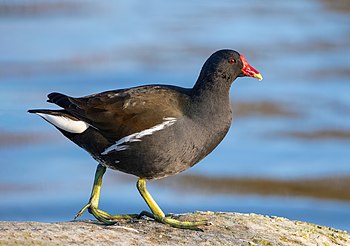
|
The common moorhen (Gallinula chloropus) is a bird species in the rail family, Rallidae. It is distributed across many parts of the Old World, from Africa to Europe and Asia. It lives around well-vegetated marshes, ponds, canals and other wetlands. A midsized to large rail, the common moorhen ranges in length from 30 to 38 cm (12 to 15 in) in length and spans 50 to 62 cm (20 to 24 in) across the wings. It gives a wide range of gargling calls and will emit loud hisses when threatened. This common moorhen was photographed in the Parc des Chanteraines near Gennevilliers in the suburbs of Paris, France. Photograph credit: Alexis Lours
Recently featured:
|
Picture of the day archives and future dates

